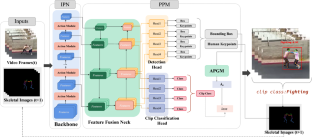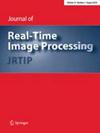基于二维 CNN 的端到端暴力行为实时检测框架
摘要
暴力行为检测(Violent behavior detection,VioBD)作为一种特殊的动作识别任务,旨在检测视频中的暴力行为,如相互厮打和攻击。暴力检测的研究已经取得了一些进展,但现有方法的实时性较差,算法性能受到复杂背景干扰和密集人群遮挡的限制。为了解决上述问题,我们提出了一种基于二维 CNN 的端到端实时暴力检测框架。首先,我们提出了一种轻量级骨骼图像(SI)作为输入模态,它可以获取人体姿态信息和更丰富的上下文信息,同时还能去除背景干扰。经测试,在相同精度下,SI 模态的分辨率仅为 RGB 模态的三分之一,大大提高了模型训练和推理的实时性,而在相同分辨率下,SI 模态的误差率更高。其次,我们还设计了并行预测模块(PPM),可以同时获得单幅图像的检测结果和视频的帧间运动信息,与传统的 "先检测图像,后理解视频 "模式相比,可以提高算法的实时性。此外,我们还提出了兼具效率和精度的辅助参数生成模块(APGM),APGM 是基于二维 CNNs 的视频理解模块,用于对视频特征的空间信息进行加权处理,处理速度可达每秒 30-40 帧,与 CNN-LSTM 等模型相比(Iqrar et al:基于 CNN-LSTM 的智能实时视频监控系统。In: 2022 14th International Conference on Mathematics, Actuarial, Science, Computer Science and Statistics (MACS), pages 1-5.IEEE,2022)和 Ludl 等人(Cristóbal:简单高效的基于姿势的实时动作识别。In: 2019 IEEE Intelligent Transportation Systems Conference (ITSC),pages 581-588.IEEE,1999),每组剪辑的传播效应速度平均每秒可提高 \(3 \sim 20\) 帧,这进一步提高了视频运动检测的效率和准确性,大大提高了实时性。我们在一些具有挑战性的基准上进行了实验,RVBDN 在长期交互中能够保持出色的速度和精度,在暴力检测和时空动作检测方法中能够满足实时性要求。最后,我们更新了新提出的暴力检测图像数据集(暴力图像数据集)。数据集可从以下网址获取:https://github.com/ChinaZhangPeng/Violence-Image-Dataset

Violent behavior detection (VioBD), as a special action recognition task, aims to detect violent behaviors in videos, such as mutual fighting and assault. Some progress has been made in the research of violence detection, but the existing methods have poor real-time performance and the algorithm performance is limited by the interference of complex backgrounds and the occlusion of dense crowds. To solve the above problems, we propose an end-to-end real-time violence detection framework based on 2D CNNs. First, we propose a lightweight skeletal image (SI) as the input modality, which can obtain the human body posture information and richer contextual information, and at the same time remove the background interference. As tested, at the same accuracy, the resolution of SI modality is only one-third of that of RGB modality, which greatly improves the real-time performance of model training and inference, and at the same resolution, SI modality has higher inaccuracy. Second, we also design a parallel prediction module (PPM), which can simultaneously obtain the single image detection results and the inter-frame motion information of the video, which can improve the real-time performance of the algorithm compared with the traditional “detect the image first, understand the video later" mode. In addition, we propose an auxiliary parameter generation module (APGM) with both efficiency and accuracy, APGM is a 2D CNNs-based video understanding module for weighting the spatial information of the video features, processing speed can reach 30–40 frames per second, and compared with models such as CNN-LSTM (Iqrar et al., Aamir: Cnn-lstm based smart real-time video surveillance system. In: 2022 14th International Conference on Mathematics, Actuarial, Science, Computer Science and Statistics (MACS), pages 1–5. IEEE, 2022) and Ludl et al. (Cristóbal: Simple yet efficient real-time pose-based action recognition. In: 2019 IEEE Intelligent Transportation Systems Conference (ITSC), pages 581–588. IEEE, 1999), the propagation effect speed can be increased by an average of \(3 \sim 20\) frames per second per group of clips, which further improves the video motion detection efficiency and accuracy, greatly improving real-time performance. We conducted experiments on some challenging benchmarks, and RVBDN can maintain excellent speed and accuracy in long-term interactions, and are able to meet real-time requirements in methods for violence detection and spatio-temporal action detection. Finally, we update our proposed new dataset on violence detection images (violence image dataset). Dataset is available at https://github.com/ChinaZhangPeng/Violence-Image-Dataset

 求助内容:
求助内容: 应助结果提醒方式:
应助结果提醒方式:


